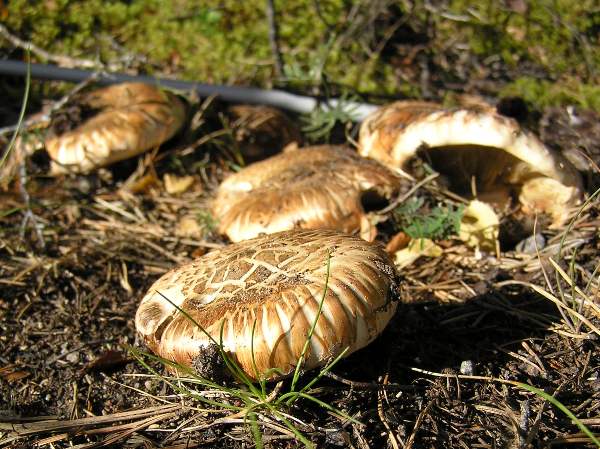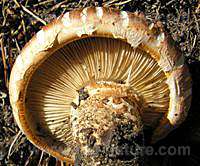Trees Birds Mammals Fish Amphibians Reptiles
Wild Algarve
Bookshop
Tricholoma focale (Fr.) Ricken - Booted Knight
Phylum: Basidiomycota - Class: Agaricomycetes - Order: Agaricales - Family: Tricholomataceae
Distribution - Taxonomic History - Etymology - Identification - Culinary Notes - Reference Sources

Tricholoma focale is quite distinctive, with its orange-brown colouring and cottony collapsing stem ring. It is also quite a large mushroom albeit not found throughout most of Britain and Ireland. One of its strongholds is in Scotland’s Caledonian Forest.
Looking rather like a spinning top, this knight with a ring was at one time moved into the genus Armillaria (with the Honey Fungus), but it is now back with the other knights of the realm (the kingdom of fungi, that is!).
Distribution
This remarkable mushroom is rarely seen in England and Wales, and it is an uncommon find in Scotland - indeed, in the Red Data List produced by Shelly Evans et al. (2006),Tricholoma focale is accorded the conservation status of Near Threatened. This rare knight occurs also in other parts of mainland Europe and in North America.
Taxonomic history
When in 1838 Elias Magnus Fries described this chunky mushroom he gave it the scientific name Agaricus focalis. (Most gilled fungi were in those days placed into a gigantic Agaricus genus, since made more manageable by redistributing most of its contents to other new genera.) It was German mycologist Adalbert Ricken (1851 - 1921) who, in 1879, transferred this species to the genus Tricholoma, thus establishing its currently-accepted scientific name as Tricholoma focale.
Synonyms of Tricholoma focale include Agaricus focalis Fr., and Armillaria focalis (Fr.) P. Karst.
Etymology
Tricholoma was established as a genus by the great Swedish mycologist Elias Magnus Fries. The generic name comes from Greek words meaning 'hairy fringe', and it must be one of the least appropriate mycological genus names, because very few species within this genus have hairy or even shaggily scaly cap margins that would justify the descriptive term.
As a specific epithet the term focale might be a derivation from the prefix foc- meaning fire... or it might not.
Identification guide
| |
Cap
Orange-brown to reddish-brown, cracking as it ages; convex, developing a flat top, margin inrolled; 7 to 12cm across. |

|
Gills
White, browning on gill edges with age; adnexed to free; moderately distant.
Stem
White and smooth above shaggy ring, patterned with bands of large brown scales below; tapering continuously towards the base; 4 to 8cm long, 2 to 4cm diameter. |
| |
Spores
Ellipsoidal, smooth, 5-8.5 x 3-6µm, with a hilar appendage; inamyloid.
Spore print
White. |
Odour/taste |
Taste not significant. Some reports refer to an odour of cucumber; others say that it has a mealy smell. I can't detect either of these. |
Habitat & Ecological role |
Ectomycorrhizal with Scots Pine - in Scotland, at least. In other countries this mushroom occurs with spruce trees as well as with various pines. |
Season |
Late summer and autumn. |
Similar species |
This mushroom bears a superficial resemblance to some specimens of Armillaria mellea, the Honey Fungus, but the broad and squat tapering stems of Tricholoma focale are very distinctive. |
Culinary Notes
Although reported in some field guides to be edible and tasty, the Booted Knight is considered by many authorities to be edible but worthless. On the basis of the evidence available, and given the rarity of this mushroom, it should be treated as just for looking, not for cooking.
Reference Sources
Fascinated by Fungi, 2nd Edition, Pat O'Reilly 2016, reprinted by Coch-y-bonddu Books in 2022.
Kibby, G (2013) The Genus Tricholoma in Britain, published by Geoffrey Kibby
Dictionary of the Fungi; Paul M. Kirk, Paul F. Cannon, David W. Minter and J. A. Stalpers; CABI, 2008
Taxonomic history and synonym information on these pages is drawn from many sources but in particular from the British Mycological Society's GB Checklist of Fungi.
Top of page...
Fascinated by Fungi. Back by popular demand, Pat O'Reilly's best-selling 450-page hardback book is available now. The latest second edition was republished with a sparkling new cover design in September 2022 by Coch-y-Bonddu Books. Full details and copies are available from the publisher's online bookshop...